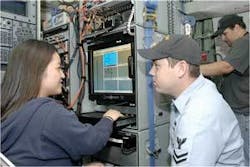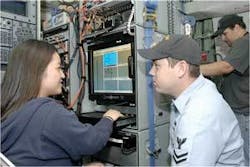Aegis BMD weapon system with prototype signal processor tracks ballistic missiles
By John McHale
KAUAI, Hawaii - The Aegis Ballistic Missile Defense (BMD) Weapon System aided by a prototype signal processor from Lockheed Martin in Moorestown, N.J., tracked several advanced ballistic missile targets in separate tests off the coast of Hawaii in April.
During both events-Critical Measurements and Countermeasures (CMCM)-2A and 2B-the Aegis AN/SPY-1B radar aboard the guided missile cruiser USS Lake Erie (CG 70), augmented by the Aegis Ballistic Missile Defense Signal Processor (BSP), provided real-time detection, tracking, and discrimination performance against threat-representative targets.
Engineers at Lockheed Martin in Moorestown, N.J., developed the Aegis BMD Weapon System and serve as the combat system engineering agent for the U.S. Navy and Missile Defense Agency (MDA)’s Aegis BMD program.
“The Aegis systems engineering philosophy of build a little, test a little, learn a lot raises performance expectations with every test,” says Joe Rappisi, Lockheed Martin’s director for Aegis BMD. “Every test pushes the envelope and engages key players at all levels, from the sailors operating the ship to the Navy, MDA and industry engineers. In these tests, the developmental Aegis BSP demonstrated new discrimination capabilities that will protect our nation, allies and forces deployed around the world against more complex ballistic missiles.”
The Aegis system has been around for about 30 years-the first ship to carry it was the guided missile cruiser USS Ticonderoga. Even though many people say it is old and out of date, that charge is not true, Rappisi says. It has state-of-the-art technology that is unsurpassed anywhere in the world, he maintains.
The Aegis BSP, which is in development and will be installed on Aegis BMD ships beginning in 2010, provides an advanced discrimination capability to defeat complex ballistic missile threats. The Aegis BSP is an open-architecture design, allowing for quick and affordable upgrades as the signal processor technology evolves.
Open architecture is the key to the BSP. All of the hardware is commercial-off-the-shelf (COTS) and has an upgrade path. The original UYK-7 and UYK-43 standard Navy computers that originally controlled the system were phased out and “we are now working with state-of-the-art equipment,” Rappisi says. The promise of open architecture is that it makes the hardware independent of the software, he adds.
The move to open architecture for Aegis BMD is in parallel and aligned with the U.S. Navy’s Aegis Open Architecture initiative to transform the entire Aegis weapon system beginning with the Cruiser Modernization Program now underway.
The BSP consists of many processors in racks on single-board computers running in parallel, Rappisi says. It provides the capability for modular band tracking and synthetic wide-band tracking, which could not be done with previous technology, Rappisi says.
Initially these processors are PowerPC technology primarily on single-board computers designed by Mercury Computer Systems in Chelmsford, Mass., says Paul Bertollotti, radar systems engineering manager for Lockheed Martin. The next step will take advantage of field programmable gate array (FPGA) technology, he adds.
The difference between today’s COTS technology and the UYK-7 and UYK 43 computers that originally ran the system is astounding, Rappisi says; it would take thousands of UYK-43s to perform the capabilities of the BSP, he explains.
The CMCM-2A and CMCM-2B tests are part of the MDA’s Critical Measurements and Countermeasures Program-an integral part of the MDA’s test process that provides participants with the opportunity to reduce technical risk by testing against stressing, complex target scenarios, Lockheed Martin officials say.
The MDA and the Navy together are developing Aegis BMD as part of the Ballistic Missile Defense System. Ultimately 15 Aegis destroyers and three Aegis cruisers will be outfitted with the capability to conduct long-range surveillance and tracking (LRS&T) and engagement of short- and medium-range ballistic missile threats using the Aegis BMD Weapon System and the Standard Missile-3 (SM-3). To date, 10 Aegis destroyers have been upgraded with the LRS&T capability and are certified for tactical deployment.
Eventually more computing capability and computers will be added to the 43 systems currently part of Aegis, Rappisi says.
The Aegis BMD Weapon System integrates the SPY-1 radar, the MK 41 Vertical Launching System, the SM-3 missile, and the weapon system’s command and control system. The Aegis BMD Weapon System also integrates with the BMDS, receiving cues from and providing cueing information to other BMDS elements.
The Aegis Weapon System is currently deployed on 79 ships around the globe with more than 30 additional ships planned or under contract. In addition to the U.S., Aegis is the maritime weapon system of choice for Japan, South Korea, Norway, Spain and Australia. Japan will begin installation of Aegis BMD in its Kongo class Aegis destroyers in 2007.

